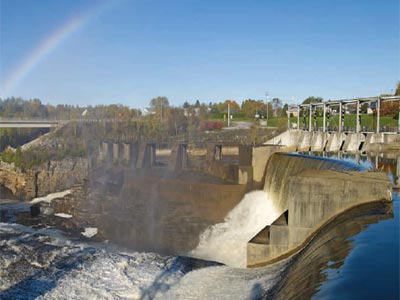
With all the turbulence in the markets these days, investors looking for a safe place to park their money should be thinking about a strong utility name like Algonquin Power (Algonquin Power Stock Quote, Charts, News, Analysts, Financials TSX:AQN). The stock is still down a bit for 2021 but portfolio manager Ryan Bushell thinks investors will do well by Algonquin as the drive to renewable energy continues to gain momentum.
“It’s been somewhat actually disappointing for this company, [but] I think that there’s lots ahead for it,” said Bushell, president of Newhaven Asset Management, who spoke on BNN Bloomberg on Thursday.
“They’re digesting some growth right now and they’ve done an equity issue to potentially pre-fund an acquisition here in the relatively near term. The stock has been kind of range bound, but a nice ten per cent dividend increase again this year and the stock yields over four and a half percent at current levels,” Bushell said.
Algonquin Power owns and operates water, natural gas and electricity utilities with revenue coming from natural gas distribution and electricity coming from renewable energy sources like hydroelectric, wind and solar.
The $12 billion market cap company is looking to spread its wings in the green economy via a public offering of 20 million units for gross proceeds of $1 billion with an option to offer an added three million units.
“The Company expects to use the net proceeds of the Offering to finance or refinance investments in renewable energy generation projects or facilities or other clean energy technologies in accordance with the Company’s Green Financing Framework. This is the fourth ‘green’ offering by the Company or its subsidiaries and aligns with AQN’s commitment to advancing a sustainable energy and water future,” Algonquin wrote in a June 18 press release.
As a high-yielding dividend utility, Algonquin’s share price has been a surprise growth engine over the past decade, moving from about $6 ten years ago to as high as C$22 by early 2020. But a sector-wide pullback in renewables earlier this year has helped bring the stock back down to the C$19-C$20 range where it’s been languishing for much of 2021.
But Bushell sees AQN as a great play for the long haul.
“Algonquin is really well set up for the next few decades with a combination of utility assets, water utilities, gas and electric utilities, that they can green and then renewable power generation and then an expertise in renewable power generation and development,” he said.
“So, I really like the company and it’s still a company we like at a full position,” Bushell said.
Earlier this month, Algonquin announced its second quarter financials, which beat top and bottom forecasts. Total revenue was up 53.5 per cent year-over-year to $527.5 million and came in above the consensus call for $445 million, while earnings of $0.15 per share were up 67 per cent compared to a year ago and beat the Street’s estimate of $0.09 per share. Adjusted EBITDA was up 39 per cent to $244.9 million. (All figures in US dollars except where noted otherwise.)
“We are pleased to report strong year-over-year earnings growth in the second quarter, supported in part by the approximately 1,400 MW of renewable energy projects placed in service since August 2020 and contributions from our recent acquisitions,” said Arun Banskota, President and CEO in an August 12 press release.
“In the quarter, we successfully completed our Midwest ‘greening the fleet’ initiative, which is expected to provide clean and cost effective energy solutions to our customers, aligning with our commitment to advancing a sustainable energy and water future,” he said.
Algonquin’s Greening the Fleet program includes 600 MW of new strategically located wind energy generation across the US Midwest along with the early retirement of a 200 MW coal facility, dropping the company’s CO2 emissions by more than 900,000 metric tons. Algonquin puts its total greenhouse gas reductions since 2017 at over one million metric tons.
Also part of its eco-friendly agenda, the company has now four GW of renewable power generation, coming from its owned and operated hydroelectric, wind and solar facilities along with its investments in renewable generating assets, putting the company on track to add 2.0 GW of renewable power between 2019 and the end of 2023.
In terms of its buildout, over the first half of 2021 Algonquin doled out $3.14 billion in capex, part of the company’s big $9.4 billion five-year capital plan running through to 2025.
“The Company’s renewable energy construction pipeline remains robust, with construction continuing to progress well on Blue Hill Wind in Saskatchewan (175 MW) and Val-Eo Wind in Quebec (24 MW) and with construction commencing on Shady Oaks II Wind in Illinois (108 MW) and New Market Solar in Ohio (100MW) in the second quarter of 2021,” Algonquin said in a press release.
Leave a Reply
You must be logged in to post a comment.




 Share
Share Tweet
Tweet Share
Share




Comment